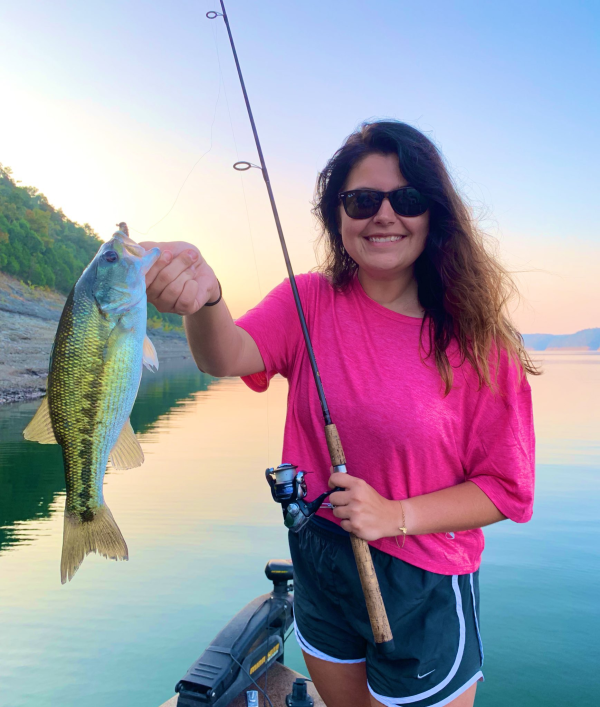Great Spots for Spotted Bass |
| By Lee McClellan from The Fishing Wire They were not even recognized as a distinctive fish species until 1927. People for many years believed these fish only existed in Kentucky. In 1956, the Kentucky legislature designated this species the “Kentucky bass” and made them the official state fish. Many anglers, especially in the south-central portion of the United States, still call the spotted bass a Kentucky bass. They pale in reputation to their black bass cousins, the largemouth and smallmouth bass, but the spunk shown once hooked and their abundance should raise the profile of the overlooked spotted bass. They are also aggressive and readily strike lures. It isn’t hard to tell when a spotted bass strikes. They shake their heads violently and dive bomb toward the bottom. The larger ones — 15 inches and up — usually grow a pronounced belly as they mature. Spotted bass use that girth along with a powerful tail that pulls against an angler, producing as good a fight as any comparable largemouth bass. Medium-light spinning rods with reels spooled with 6-pound fluorocarbon line is all you need for catching spotted bass. Once the fall winds blow, spotted bass begin to school up. They locate along rock bluffs or suspend over points, submerged humps or channel drops. “At this time of year, if you catch one spotted bass, keep fishing that same spot,” said Chad Miles, host of the Kentucky Afield television show and dedicated spotted bass angler. “There might be 40 or 50 of them there. Spotted bass really school up in fall. ”In early to mid-fall, these schools of spots often trap a cloud of shad against the surface and rip into them. Large, chrome topwater lures tossed into this melee draw vicious strikes. These same lures fished over points, humps and channel drops can draw spotted bass from a good distance below the lure, especially on our clear water lakes such as Lake Cumberland or Laurel River. Lake.Lake Cumberland holds a bountiful population of spotted bass with many fish in the 14- to 16-inch range. Spotted bass make up roughly half of the black bass found in the lake. The main lake points from Harmon Creek down to Wolf Creek Dam hold spotted bass from fall through late spring. A 4-inch black finesse worm rigged on a 3/16-ounce Shakey head and slowly fished down those points is a deadly choice. A hammered silver jigging spoon fished along the old Cumberland River bluffs in this section of the lake also produces spotted bass. Again, if you catch one spotted bass in fall, keep fishing the same area with the same technique. You might catch a dozen or more. Large crappie minnows fished on size 1 circle hooks with two split shot lightly clamped on the line about 18 inches above the hook make a powerful choice for the large spotted bass in Laurel River Lake. The water of Laurel River Lake is as clear as the air and live bait works best.The upper end of the Craigs Creek arm is a spotted bass hotspot on Laurel, as are the main lake points near the dam and in the lower section of Spruce Creek. The mid-depth reservoirs in southern Kentucky hold excellent populations of larger spotted bass. Barren River Lake and Green River Lake hold some of the largest spotted bass in Kentucky. The channel drops along the submerged Barren River adjacent to Barren River Lake State Park and the Narrows Access Area make excellent fall spots to try for spotted bass.In Green River Lake, rock slides and points in the lower sections of the Robinson Creek arm and Green River arm are the best fall places. Green River Lake holds an impressive number of spotted bass longer than 15 inches. Anglers fishing for largemouth bass in Kentucky Lake often stumble across a football-sized spotted bass. The secondary points in the major bays and creek arms in the middle section of the lake hold some impressive spotted bass in fall. Smaller profile ¼-ounce football jigs in hues of green, brown and chartreuse attract these fish on Kentucky Lake.Spotted bass make excellent table fare, by far the best tasting of the black bass species, similar to crappie in taste and texture. There is no minimum size limit on spotted bass statewide, but they still count toward the six fish aggregate black bass daily creel limit. Hit the water and land some hard fighting and abundant spotted bass this fall. Keeping a few medium-sized spots for the table makes a delicious and nutritious meal. Author Lee McClellan is a nationally award-winning associate editor for Kentucky Afield magazine, the official publication of the Kentucky Department of Fish and Wildlife Resources. He is a life-long hunter and angler, with a passion for smallmouth bass fishing. |
